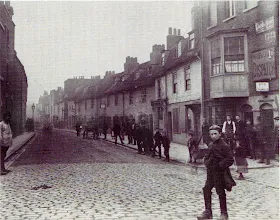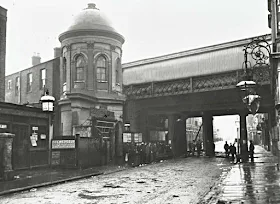This chandle'r shop was located at No 53 Addey Street Deptford
This website is dedicated to the past History of Deptford. If you have any stranger than fiction stories about Deptford I would welcome your input. This may include stories of the people, the places still here or long gone, the characters, the war years, ghost stories and haunted places, ancient buildings and bygone memories, long forgotten. You can contact me with your stories at axelgs1@yahoo.co.uk
Wednesday, 13 November 2013
Stowage 1904
This old photo of the Stowage also shows St Nicholas's Church just in view on the left and the Charnel House left/centre.
A Charnel House is a vault or building where human skeletal remains are stored. They are often built near churches for depositing bones that are unearthed while digging graves The term can also be used more generally as a description of a place filled with death and destruction. The Charnel House was also known as the Watch House or Mortuary and was built soon after the rebuilding of the main part of the church at the end of the 17th C. At that time, bodies would be laid there for safekeeping. The building was restored in 1958.
Tuesday, 5 November 2013
London Gazette 4th November 1864
James Pearcey, of the Ship Defiance, Grove-street, Deptford, in the county of Kent, Licensed Victualler,"
Master Lumper and Stevedore, having been adjudged bankrupt under a Petition for adjudication of Bankruptcy, filed in Her Majesty's Court of Bankruptcy, in London, on the 10th day of October, 1864, a public sitting, for the said bankrupt to pass his Last Examination, and make application for his Discharge, will .be held before John Samuel Martin Fonblanque, Esq., a Commissioner of the said Court, on the 2nd day of December next, at the said Court, at Basinghall-street, in the city of London, at two o'clock in the afernoon precisely, the day last aforesaid being the day limited for the said bankrupt to surrender. Mr. Herbert Harris Cannan, of No. 36, Basinghall-street, is the Official Assignee, and Mr. W. W. Aldridge, of No. 46, Moorgate-street, is the Solicitor acting in the bankruptcy.
Sunday, 3 November 2013
Deptford, Grove Street Fire
London Fires in 1851.
Fires are continually occasioned by domestic animals, cats, dogs, rats, &c* The past year presented a novelty in the
Remarkable Discovery of a Fire by a Horse. — On Thursday, February 13th, about 1 a.m., intelligence was given at the fire- engine stations in London that a fire had broken out in Grove Street, Deptford, at the " Ship Defiance," public house. This fire was, however, promptly extinguished by the inmates and police. The messenger who gave the alarm at the West of England Fire-engine Station made a mistake, saying Globe Street. The engine was instantly horsed and started ; and Globe Street, Deptford, not being known to the firemen, they kept the high-road, trusting to the receipt of more precise and accurate information as they approached Deptford. Proceeding along at their usual rapid rate, they reached High Street, Deptford, when all of a sudden one of the engine-horses came to a dead stop, and refused to move a step further. Encouraging words and the whip were resorted to, but the only result was the horse's throwing himself on his haunches. Surprised at this extraordinary occurrence, curiosity was excited, when one of the firemen, addressing Mr. Connorton, the Superintendent, exclaimed — " Good God ! this house is on fire," pointing at the same time to the house opposite which the horse had so unaccountably stopped. The premises in question belonged to Mr. Wright, seedsman and corn-chandler, and on looking through the fanlight, the fire was found raging in the shop. The firemen instantly roused the neighbours ; and having collected a number of pails filled with water, they then broke open the shop door, and had nearly extinguished the fire before the policeman on the beat knew of the occurrence.
Thursday, 26 September 2013
Mill Lane, 1903.
Mill Lane now Brookmill Road. Photograph taken from Deptford Broadway. The buildings on the right were originally lodging houses but were demolished in 1895 to make way for another lodging house, Carrington House.
Manning's Soup and Pie Shop 1904.
Manning's Pie & Soup House or 'The Old Pudden Shop' as it was also known was located at No. 147 Deptford High Street. Pay sixpence for the best meal in the world! It was demolished in 1907
Wednesday, 29 May 2013
At the Kings Head 1649
During my
research I came across this token stamped Kings Head in Deptford. Its a 1/4p
Traders Trading Token. Could this refer to the Kings Head Public House which
was on the corner of Church Street and Albury Street ? Trade tokens were
issued in the 17th century, between 1648 and 1673, in response to a lack of low
denomination being produced by the crown. To ease the monetary situation,
boroughs and cities across the country, began producing tokens to be used
within the locality; in London the situation differed, due to the scale of the
population, needed to issue private tokens, rather than one accepted city wide.
Tokens were
issued by tradesmen for their business, and would also be accepted by other
traders in the locality, as long as they knew the issuer and were assured that
they would be able to redeem the value of the token. In a period when people
often lived their entire lives within a relatively small area, this system
would rely on the trust of the businesses in the neighbourhood. Tradesmen would
keep a tray below their counter, where they would collect tokens from other
issuers, and then redeem their collected value with the issuer.
Trade tokens
were most commonly issued, as farthing, half penny, and penny denominations.
Tokens were only issued as farthing tokens until 1656, when half penny tokens
began to be brought in to circulation. With the silver half penny of the crown
going out of use in 1661, this will have further increased the need for a half
penny token, and it was at this time that it became a more common issue than
the farthing. Penny tokens, were also issued by traders, most commonly by
coffee-houses, the goods they sold being of a higher value than may be common
elsewhere. There are also a small number of instances where higher
denominations of coinage were issued, including tuppence and sixpence.
A variety of
information would be represented on the trade tokens; this could include, the
place of issue, the issuers name, their trade, the denomination, with the
denomination, the farthing often was not marked, it was recognisable by its
smaller size, but the half penny and penny tokens often had the denomination
written on them, in text or numerically. Most commonly featured, was a triad of
initials representing those of the issuer, and their wife (or sometimes son).
Read on the token from left to right and the up, the middle initial would be
that of the wife.
Throughout
the period of issue for the trade tokens, there were often plans by the Crown
to produce farthings, it was only in 1672, that the first was finally issued.
On the 16th August 1672, a proclamation was made by the crown, ordering the minting
of trade tokens to cease, a further proclamation was issued in 1673, but it was
only with the issue of a third proclamation in 1674, that the issue of trade
tokens, finally ceased. By this time the use of trade tokens had once again,
begun to fall, so the latest dates for tokens, are relatively rare.
Monday, 27 May 2013
The Parrish Family Lamerton Street
I recently made contact with a gentleman by the name of Roy Parrish. He sent me this brief insight of his younger life whilst living in Lamerton Street. His description of the house and living conditions mirrors exactly the recollection I have of my grandmothers house in Albury Street, particularly avoiding using the outside toilet especially after dark! Roy say's........
"My grandfather lived there from the mid 20th century when the street was still a fairly new. The house where my grandfather and father lived was very dark inside, and to a very young boy like myself then in the 1950s a very creepy environment to live in. There was another family who lived in their house and they resided on the ground floor with our Parrish family of eight living on the floor above, so you can see they were very cramped conditions to live in. The High street end of Lamerton Street backed on to the old post office in Creek Road and the yard had the usual outside toilet which I always managed not to use! As a point of interest I did my family tree some years back and was fortunate to do my whole family in one afternoon as all the records from St Alfege's church showed their family had been living in Deptford since the 18th century".
Roy has a number of stories which he can recall from over the years and when he has passed them on to me I will post them.
"My grandfather lived there from the mid 20th century when the street was still a fairly new. The house where my grandfather and father lived was very dark inside, and to a very young boy like myself then in the 1950s a very creepy environment to live in. There was another family who lived in their house and they resided on the ground floor with our Parrish family of eight living on the floor above, so you can see they were very cramped conditions to live in. The High street end of Lamerton Street backed on to the old post office in Creek Road and the yard had the usual outside toilet which I always managed not to use! As a point of interest I did my family tree some years back and was fortunate to do my whole family in one afternoon as all the records from St Alfege's church showed their family had been living in Deptford since the 18th century".
Roy has a number of stories which he can recall from over the years and when he has passed them on to me I will post them.
 |
| Lamerton Street. |
Sunday, 26 May 2013
Tuesday, 21 May 2013
Wednesday, 3 April 2013
Sweet Shop in Church Street - 1940's - 50's
I believe this is the sweet shop just round the corner from Albury Street heading south to the Broadway.
After a bit of research the shop wasn't around the corner of Albury Street. It was in fact located by the Broadway as this sketch by Thankful Sturdey shows. Shops to the left were demolished in the 1940's
After a bit of research the shop wasn't around the corner of Albury Street. It was in fact located by the Broadway as this sketch by Thankful Sturdey shows. Shops to the left were demolished in the 1940's
.JPG)


.jpg)



EE9s2ufh,sBRo2lNR6)w~~60_58.JPG)











